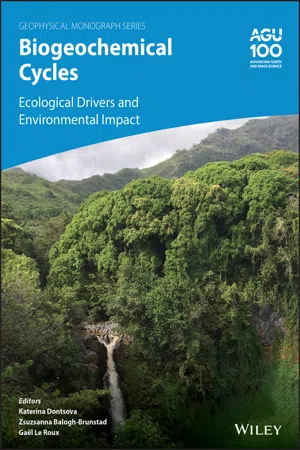
Biogeochemical Cycles
Ecological Drivers and Environmental Impact
- English
- ePUB (mobile friendly)
- Available on iOS & Android
Biogeochemical Cycles
Ecological Drivers and Environmental Impact
About this book
Elements move through Earth's critical zone along interconnected pathways that are strongly influenced by fluctuations in water and energy. The biogeochemical cycling of elements is inextricably linked to changes in climate and ecological disturbances, both natural and man-made.
Biogeochemical Cycles: Ecological Drivers and Environmental Impact examines the influences and effects of biogeochemical elemental cycles in different ecosystems in the critical zone.
Volume highlights include:
- Impact of global change on the biogeochemical functioning of diverse ecosystems
- Biological drivers of soil, rock, and mineral weathering
- Natural elemental sources for improving sustainability of ecosystems
- Links between natural ecosystems and managed agricultural systems
- Non-carbon elemental cycles affected by climate change
- Subsystems particularly vulnerable to global change
The American Geophysical Union promotes discovery in Earth and space science for the benefit of humanity. Its publications disseminate scientific knowledge and provide resources for researchers, students, and professionals. Find out more about this book from this Q&A with the Author. Book Review: http://www.elementsmagazine.org/archives/e16_6/e16_6_dep_bookreview.pdf
Frequently asked questions
- Essential is ideal for learners and professionals who enjoy exploring a wide range of subjects. Access the Essential Library with 800,000+ trusted titles and best-sellers across business, personal growth, and the humanities. Includes unlimited reading time and Standard Read Aloud voice.
- Complete: Perfect for advanced learners and researchers needing full, unrestricted access. Unlock 1.4M+ books across hundreds of subjects, including academic and specialized titles. The Complete Plan also includes advanced features like Premium Read Aloud and Research Assistant.
Please note we cannot support devices running on iOS 13 and Android 7 or earlier. Learn more about using the app.
Information
Part I
Biological Weathering
1
Biological Weathering in the Terrestrial System: An Evolutionary Perspective
ABSTRACT
Weathering is the process by which a solid breaks up into its building blocks when in thermodynamic disequilibrium with the surrounding environment. Weathering plays an important role in the formation of environments that can support life, including human life. It provides long‐term control on nutrient availability in natural and agricultural ecosystems through release of lithogenic elements and formation of secondary minerals that allow storage of nutrients in soils. Life itself, however, has a profound effect on weathering processes. Absence of oxidants characterized the weathering environment on early Earth (4.6–2.4 Ga), when CO2 released during volcanic activity was the principal driver of weathering processes. The advent of photosynthesis in the Archean and resulting biogenic flux of O2 to the atmosphere, ultimately shifted weathering towards oxidation, influencing the mineral landscape and the cycles of nutrients that supported an evolving biosphere. Land colonization by vascular plants in the early Phanerozoic and evolution of mycorrhizal symbiosis enhanced weathering by selectively mining minerals and redistributing nutrients across plant and fungi in the ecosystem. Development of complex human societies and the ever‐increasing influence people exert on the environment further impact weathering and nutrient cycling, both directly and indirectly.
1.1. INTRODUCTION
1.2. WEATHERING


1.3. THE EARLY ANOXIC EARTH
Table of contents
- Cover
- Table of Contents
- CONTRIBUTORS
- PREFACE
- ACKNOWLEDGMENTS
- Part I: Biological Weathering
- Part II: Elemental Cycles
- Part III: Frontier and Managed Ecosystems
- INDEX
- End User License Agreement